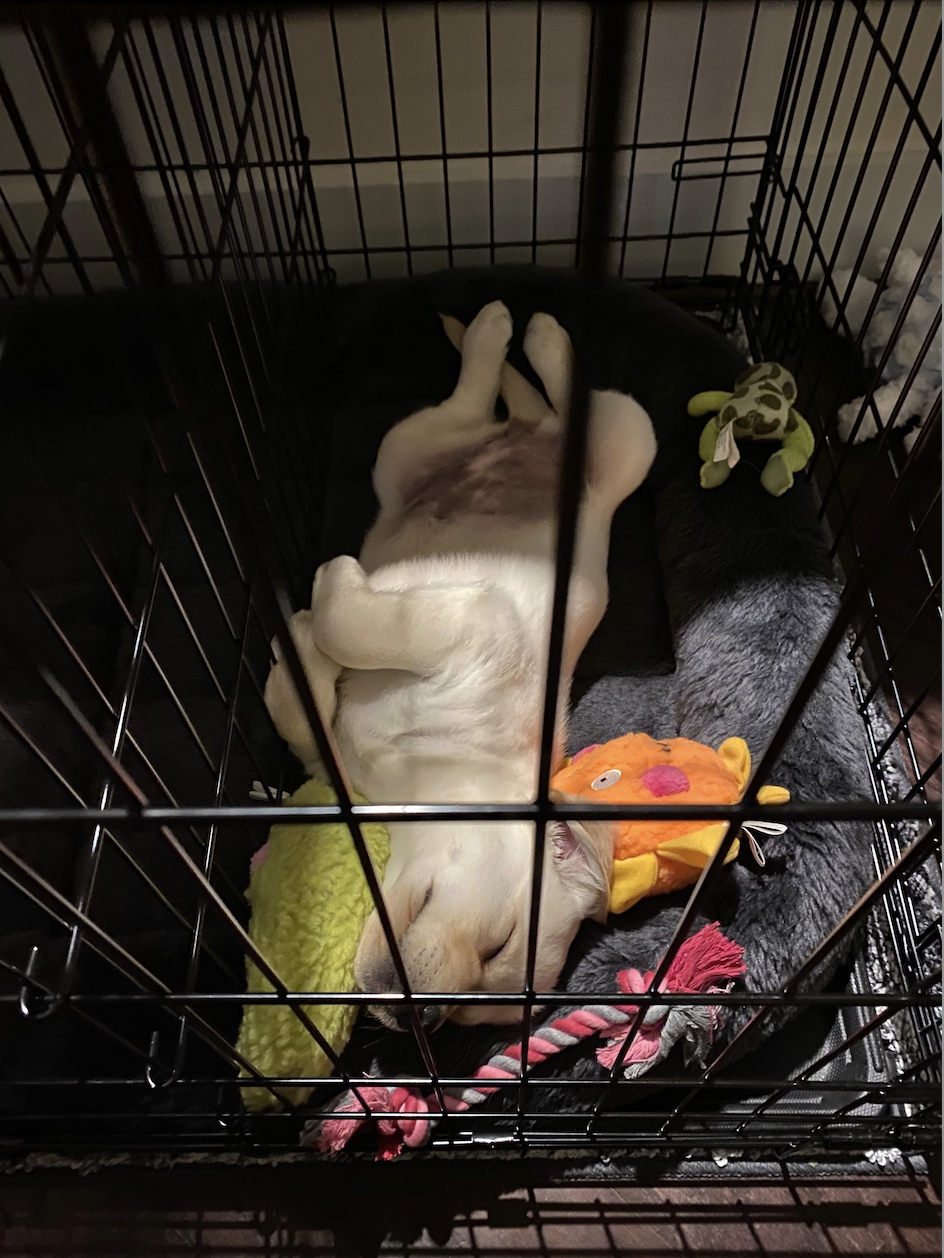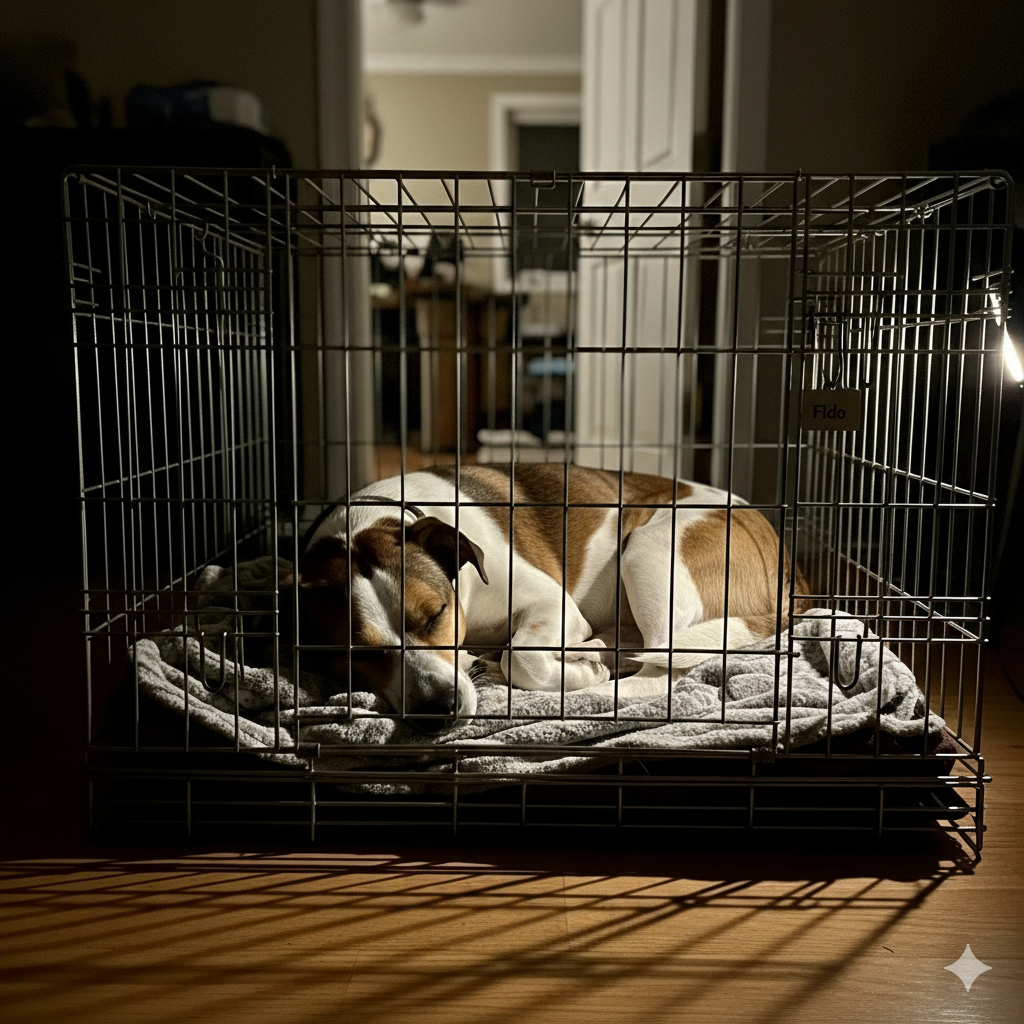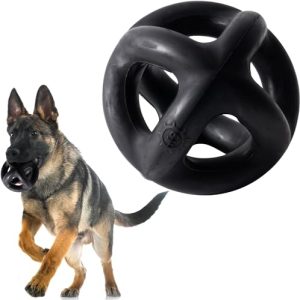Have you ever wondered if crating your dog at night is actually kind or if it might be causing them harm? You want the best for your furry friend, but the idea of locking them in a crate can feel uncomfortable.
What if it’s stressful or even cruel? Understanding the truth behind nighttime crating can help you make the right choice for your dog’s comfort and well-being. Keep reading to discover what experts say, how your dog really feels, and practical tips to ensure your pet stays happy and safe while you both get a good night’s rest.
Benefits Of Crate Training
Crate training offers more than just a place for your dog to sleep. It creates a controlled environment that benefits both you and your pet in several important ways. Understanding these benefits can help you see crate training not as a punishment but as a practical tool to support your dog’s well-being.
Safety And Security
Your dog’s crate acts as a personal den, providing a safe space where they can retreat and relax. It prevents them from wandering into dangerous areas of your home at night, such as chewing on electrical cords or ingesting harmful substances.
Think about times when your dog seemed stressed or overwhelmed. A crate can become their sanctuary, offering a sense of comfort and security that helps reduce anxiety.
Housebreaking Aid
Crate training is one of the most effective ways to speed up housebreaking. Dogs naturally avoid soiling their sleeping area, which encourages them to hold it until you take them outside.
Have you noticed how puppies tend to whine or scratch when they need to go out? Crates help you catch these signals early, making the training process smoother and less frustrating for both of you.
Preventing Destructive Behavior
When left unsupervised, dogs—especially puppies—can get into trouble by chewing furniture, shoes, or other household items. A crate confines them to a dog-proof area, reducing the risk of damage.
Using a crate doesn’t mean you’re ignoring your dog’s need for exercise and attention. Instead, it helps you manage their time and energy wisely, preventing boredom-driven mischief.
Potential Downsides Of Crating
Crating a dog at night is a common practice, but it’s important to weigh its potential downsides carefully. While crates can offer safety and comfort, they might also bring challenges that affect your dog’s well-being. Understanding these risks helps you make choices that respect your dog’s needs and personality.
Stress And Anxiety Risks
Dogs are social animals, and being confined to a crate for long periods can increase stress and anxiety. Some dogs may develop a fear of the crate itself, associating it with isolation or punishment. Have you noticed your dog whining or scratching at the crate door? These behaviors often signal discomfort or distress.
Stress can lead to destructive behaviors or excessive barking when your dog is finally let out. To minimize anxiety, ensure the crate is a positive space, filled with toys or treats. But if your dog shows persistent signs of stress, it might be time to rethink crating as a nighttime solution.
Physical Discomfort
Crates limit movement, which can cause physical discomfort over time. Dogs need to stretch and change positions to avoid stiffness or muscle cramps. Smaller crates, in particular, can prevent your dog from lying comfortably, leading to restless nights.
Older dogs or those with joint issues may suffer more when crated too long. Pay attention to how your dog behaves after sleeping in the crate—any limping or reluctance to move could indicate discomfort. Providing proper bedding and choosing the right crate size can ease some physical strain.
Impact On Socialization
Nighttime crating reduces your dog’s interaction with family members during crucial bonding hours. Dogs learn and feel secure through social connection, and limiting this time may hinder their emotional growth. Ask yourself: does your dog seem more withdrawn or less responsive after spending nights isolated?
Less socialization can affect behavior during the day, making dogs more anxious or aggressive. To balance crate use, try spending quality time with your dog before and after crating. This helps maintain a healthy bond and supports your dog’s social development.
Ethical Considerations
Considering the ethics of crating a dog at night means looking beyond convenience. It’s about understanding your pet’s emotional and physical needs. You have to weigh comfort against safety and boundaries, all while keeping your dog’s well-being at the center.
Balancing Needs And Comfort
Your dog needs a safe space, but it should also feel comfortable and welcoming. A crate can become a cozy den if set up properly with soft bedding and toys. Think about whether your dog feels secure or trapped—this feeling changes everything.
Have you noticed how your dog reacts when you close the crate door? Some dogs settle quickly, while others may whine or pace. These reactions can tell you if the crate is meeting their emotional needs or causing stress.
Duration And Timing
How long your dog spends in the crate matters a lot. Leaving a dog in a crate for too many hours can lead to discomfort and anxiety. Most experts suggest limiting crate time to a few hours overnight, ensuring your dog has enough bathroom breaks and exercise before bedtime.
Ask yourself: Is the crate being used as a temporary space or as a long-term confinement? The timing should support your dog’s natural rhythms, not disrupt their sleep or comfort.
Individual Dog Differences
Every dog is unique, and their reaction to crating can vary widely. Some breeds and personalities thrive with crate training, while others may find it stressful. Your dog’s history, temperament, and health all influence how ethical crating feels in practice.
Have you observed how your dog responds to different environments? Tailoring your approach based on your dog’s individual needs will help you avoid causing unnecessary distress. Paying close attention to these signals is key to making an ethical choice.

Credit: www.hbhonde.com
Alternatives To Night Crating
Crating a dog at night is common, but not the only choice. Many pet owners seek gentle ways to keep their dogs safe and comfortable. Alternatives to night crating offer freedom without risk. These options help your dog feel secure while avoiding confinement.
Designated Dog-friendly Spaces
Create a special area just for your dog. Use a cozy bed, soft blankets, and familiar toys. This space should be quiet and free from hazards. It helps your dog relax and sleep peacefully. Make sure the area is easy to clean and well-ventilated.
Free Roaming With Safety Measures
Allow your dog to move freely in safe parts of your home. Remove sharp objects, cords, and toxic plants. Close doors to rooms that are unsafe. Use night lights to avoid accidents. This method gives dogs comfort and space to explore.
Use Of Baby Gates Or Playpens
Baby gates or playpens limit your dog’s movement gently. They keep your dog in one area without the feeling of being trapped. Choose gates tall enough to prevent jumping over. Playpens offer a larger space for stretching and playing safely.
Tips For Humane Crate Use
Using a crate humanely can change how your dog feels about their space. The right approach turns the crate into a cozy, safe spot instead of a punishment zone. Here are some practical tips to ensure your dog’s crate time is kind and comfortable.
Proper Crate Size And Setup
Your dog’s crate should be just the right size—not too big, not too small. It needs to be large enough for your dog to stand, turn around, and lie down comfortably. Too much extra space can make it feel less secure, while a cramped crate can cause discomfort.
Set up the crate with soft bedding and a few favorite toys. Avoid anything that could be chewed up and swallowed. If your dog enjoys looking outside, position the crate near a window but away from drafts or loud noises.
Positive Reinforcement Techniques
Make the crate a happy place by associating it with good things. Use treats and praise whenever your dog enters the crate willingly. This helps your dog understand the crate is a reward, not a punishment.
Try feeding your dog meals inside the crate or tossing in a special chew toy. If your dog resists, don’t force them in. Instead, encourage them slowly with gentle words and rewards, building trust over time.
Establishing A Comfortable Routine
Consistency helps your dog feel secure about crate time. Create a nightly routine that includes some playtime, a bathroom break, then calm time in the crate. Predictability reduces anxiety and sets clear expectations.
Watch your dog’s behavior closely. Are they calm or restless in the crate? Adjust the routine if needed, like adding extra exercise earlier in the day to help them settle at night. Have you noticed how your dog’s comfort improves when they know what to expect?

Credit: emlabradors.com

Credit: pupford.com
Frequently Asked Questions
Is Crating A Dog At Night Considered Cruel?
Crating a dog at night is not cruel if done properly. It provides safety and comfort when the crate is cozy and sized well. Dogs often feel secure in crates, but long confinement or neglect can be harmful.
How Long Can A Dog Stay In A Crate Overnight?
Dogs can stay in crates overnight for about 6 to 8 hours. Puppies and elderly dogs need shorter durations. Ensure the dog has bathroom breaks before bedtime and a comfortable environment inside the crate.
What Are The Benefits Of Crating A Dog At Night?
Crating at night helps with house training and prevents destructive behavior. It creates a safe space and reduces anxiety. Proper crate use enhances sleep quality for both dog and owner.
Can Crating At Night Cause Anxiety In Dogs?
Crating can cause anxiety if introduced abruptly or used excessively. Gradual training and positive reinforcement reduce stress. A well-introduced crate becomes a calm and secure resting place.
Conclusion
Crating a dog at night can be kind if done right. Dogs need comfort, space, and time to adjust. Use the crate as a safe place, not a punishment. Watch your dog’s behavior and feelings closely. A calm, happy dog means you are doing well.
Remember, every dog is different. Patience and care make crating a good choice.

Emily Barker is the founder of ChillDogLife.com, a space dedicated to helping pup parents discover the best dog products, lifestyle tips, and cozy ideas for happier homes.
A lifelong dog lover, Emily combines her passion for pets with a knack for research to share trusted recommendations on everything from toys and furniture to health and everyday care.
Her goal is simple: to make life easier, stylish, and more joyful for dogs and the people who love them.







